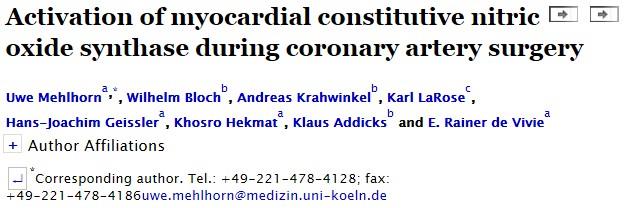The Role of Nitric Oxide in Myocardial Ischemia / Reperfusion

(Click above to view source article)
ABSTRACT
=
Objective:
The role of nitric oxide (NO) in myocardial ischemia/reperfusion is controversial. While some studies have shown cardioprotective effects of NO, others suggested that increased myocardial NO release secondary to ischemia may contribute to reperfusion injury.
However, the impact of cardioplegia-induced myocardial ischemia/reperfusion on the activity of the NO-producing enzyme constitutive NO-synthase (cNOS or NOS-III) has not been investigated.
Methods:
Twenty elective CABG patients were randomized to receive myocardial protection using either intermittent cold blood cardioplegia with ‘hot-shot’ (CBC; n=10) or continuous warm blood enriched with the ultra-fast-acting β-blocker esmolol (WBE; n=10).
We collected transmural LV biopsies prior to cardiopulmonary bypass (CPB), at the end of the cross-clamp period, and at the end of CPB. Specimen were subjected to immunocytochemical staining against myocardial NOS-III and cGMP using polyclonal antibodies.
NOS-III activity was determined using TV-densitometry (gray units) and cGMP content using a semiquantitative score. Global myocardial metabolism was assessed by arterio-coronary sinus lactate concentration difference (a-csDLAC). For LV function determination we measured the fractional area of contraction (FAC) using TEE.
Results:
In CBC hearts a-csDLAC was significantly decreased following cross-clamp removal as compared to pre-CPB indicating global ischemia during cross-clamp.
In contrast, a-csDLAC was unchanged in WBE hearts indicating absence of relevant ischemia in this group. In CBC hearts NOS-III activity did not change from pre-CPB (35.6±11.1 U) to the end of the cross-clamp period (38.0±8.1 U; P=0.2), but increased significantly to 48.5±12.1 U at the end of CPB following initial warm blood reperfusion (P=0.026).
In WBE hearts NOS-III activity remained unchanged throughout (29.2±10.8, 35.1±11.8, and 32.2±14.7 U, respectively; P≫0.3).
At the end of CPB, nine CBC hearts, but only one WBE heart showed increased cGMP content (P=0.002). Compared to pre-CPB, FAC in the CBC group was 109±25% following weaning off CPB (P=0.26), but was slightly decreased to 87±22% at 4 h post-CPB (P=0.03). In the WBE group FAC remained unchanged compared to pre-CPB throughout (103±21 and 96±37%, respectively; P≫0.5).
Conclusions:
Our data show that global myocardial ischemia and reperfusion induced by CBC is associated with myocardial NOS-III activation and increased cGMP content suggesting increased NO release. In contrast, avoidance of ischemia by use of WBE prevented NOS-III and c-GMP increase.
As LV function was decreased at 4 h post-CPB in the CBC group, these data suggest that increased NO release secondary to NOS-III activation may have contributed to ischemia-reperfusion injury as has been shown experimentally.



